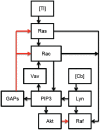A mathematical model of CR3/TLR2 crosstalk in the context of Francisella tularensis infection
- PMID: 23133361
- PMCID: PMC3486853
- DOI: 10.1371/journal.pcbi.1002757
A mathematical model of CR3/TLR2 crosstalk in the context of Francisella tularensis infection
Abstract
Complement Receptor 3 (CR3) and Toll-like Receptor 2 (TLR2) are pattern recognition receptors expressed on the surface of human macrophages. Although these receptors are essential components for recognition by the innate immune system, pathogen coordinated crosstalk between them can suppress the production of protective cytokines and promote infection. Recognition of the virulent Schu S4 strain of the intracellular pathogen Francisella tularensis by host macrophages involves CR3/TLR2 crosstalk. Although experimental data provide evidence that Lyn kinase and PI3K are essential components of the CR3 pathway that influences TLR2 activity, additional responsible upstream signaling components remain unknown. In this paper we construct a mathematical model of CR3 and TLR2 signaling in response to F. tularensis. After demonstrating that the model is consistent with experimental results we perform numerical simulations to evaluate the contributions that Akt and Ras-GAP make to ERK inhibition. The model confirms that phagocytosis-associated changes in the composition of the cell membrane can inhibit ERK activity and predicts that Akt and Ras-GAP synergize to inhibit ERK.
Conflict of interest statement
The authors have declared that no competing interests exist.
Figures



 ) activates Lyn, which leads to the activation of PI3K and the accumulation of PIP3 at the immunological synapse. PIP3, recruits positive (Vav) and negative (GAP) regulators of Ras and Rac to the immunological synapse. (In this simplified model active Raf serves as a proxy for active ERK, as explained in the text. Red arrows denote inhibition, black arrows denote stimulation.)
) activates Lyn, which leads to the activation of PI3K and the accumulation of PIP3 at the immunological synapse. PIP3, recruits positive (Vav) and negative (GAP) regulators of Ras and Rac to the immunological synapse. (In this simplified model active Raf serves as a proxy for active ERK, as explained in the text. Red arrows denote inhibition, black arrows denote stimulation.)
 ,
,  ).
).
 ,
,  ).
).
 ,
,  ).
).
 ,
,  ).
).
 ,
,  ).
).
 ,
,  ).
).
 ,
,  ).
).
 ,
,  ).
).



Similar articles
-
Complement Receptor 3-Mediated Inhibition of Inflammasome Priming by Ras GTPase-Activating Protein During Francisella tularensis Phagocytosis by Human Mononuclear Phagocytes.Front Immunol. 2018 Mar 26;9:561. doi: 10.3389/fimmu.2018.00561. eCollection 2018. Front Immunol. 2018. PMID: 29632532 Free PMC article.
-
Fine tuning inflammation at the front door: macrophage complement receptor 3-mediates phagocytosis and immune suppression for Francisella tularensis.PLoS Pathog. 2013 Jan;9(1):e1003114. doi: 10.1371/journal.ppat.1003114. Epub 2013 Jan 24. PLoS Pathog. 2013. PMID: 23359218 Free PMC article.
-
Francisella tularensis disrupts TLR2-MYD88-p38 signaling early during infection to delay apoptosis of macrophages and promote virulence in the host.mBio. 2023 Aug 31;14(4):e0113623. doi: 10.1128/mbio.01136-23. Epub 2023 Jul 5. mBio. 2023. PMID: 37404047 Free PMC article.
-
Innate Immune Recognition: An Issue More Complex Than Expected.Front Cell Infect Microbiol. 2019 Jul 3;9:241. doi: 10.3389/fcimb.2019.00241. eCollection 2019. Front Cell Infect Microbiol. 2019. PMID: 31334134 Free PMC article. Review.
-
Uptake and intracellular fate of Francisella tularensis in human macrophages.Ann N Y Acad Sci. 2007 Jun;1105:160-86. doi: 10.1196/annals.1409.001. Epub 2007 Apr 13. Ann N Y Acad Sci. 2007. PMID: 17435118 Review.
Cited by
-
Complement Receptor 3-Mediated Inhibition of Inflammasome Priming by Ras GTPase-Activating Protein During Francisella tularensis Phagocytosis by Human Mononuclear Phagocytes.Front Immunol. 2018 Mar 26;9:561. doi: 10.3389/fimmu.2018.00561. eCollection 2018. Front Immunol. 2018. PMID: 29632532 Free PMC article.
-
Exosomal miRs in Lung Cancer: A Mathematical Model.PLoS One. 2016 Dec 21;11(12):e0167706. doi: 10.1371/journal.pone.0167706. eCollection 2016. PLoS One. 2016. PMID: 28002496 Free PMC article.
-
A mechanistic modelling approach of the host-microbiota interactions to investigate beneficial symbiotic resilience in the human gut.J R Soc Interface. 2024 Jun;21(215):20230756. doi: 10.1098/rsif.2023.0756. Epub 2024 Jun 20. J R Soc Interface. 2024. PMID: 38900957 Free PMC article.
-
Mathematical Models for Immunology: Current State of the Art and Future Research Directions.Bull Math Biol. 2016 Oct;78(10):2091-2134. doi: 10.1007/s11538-016-0214-9. Epub 2016 Oct 6. Bull Math Biol. 2016. PMID: 27714570 Free PMC article. Review.
-
Non-canonical Activation of Akt in Serum-Stimulated Fibroblasts, Revealed by Comparative Modeling of Pathway Dynamics.PLoS Comput Biol. 2015 Nov 10;11(11):e1004505. doi: 10.1371/journal.pcbi.1004505. eCollection 2015 Nov. PLoS Comput Biol. 2015. PMID: 26554359 Free PMC article.
References
-
- Aderem A (2002) How to eat something bigger than your head. Cell 12: 5–8. - PubMed
-
- Edwards JL, Brown EJ, Uk-Nham S, Cannon JG, Blake MS, et al. (2002) A co-operative interaction between Neisseria gonorrhoeae and complement receptor 3 mediates infection of primary cervical epithelial cells. Cell Microbiol 4: 571–584. - PubMed
-
- Bajtay Z, Speth C, Erdei A, Dierich M (2004) Cutting edge: productive HIV-1 infection of dendritic cells via complement receptor type 3 (CR3, CD11b/CD18). J Immunol 173: 4775–4778. - PubMed
Publication types
MeSH terms
Substances
Grants and funding
LinkOut - more resources
Full Text Sources
Miscellaneous

